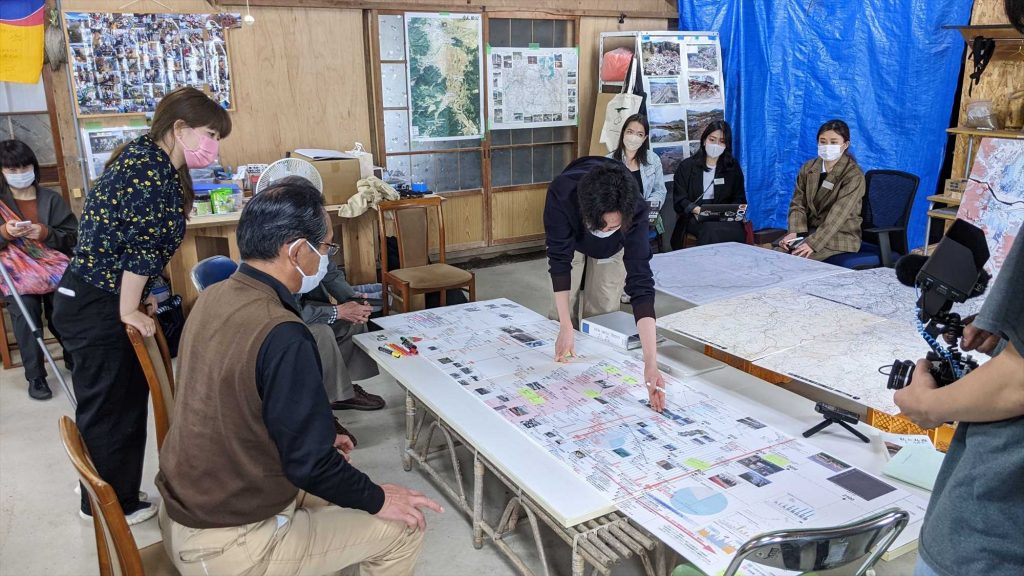20221111
Marumori, Miyagi 10, June, 2022
We took the Shinkansen from Tokyo to Sendai and drove directly to Marumori. Around noon we arrived at Sairi Yashiki – the residence of Risuke Saito, a wealthy merchant active in the Taisho era (1912-1926) and a local museum from that era. There, Haruka Komori and Natsumi Seo are currently holding the exhibition “Yamatsunami, Amema no Katarai”. Photos and stories of Marumori before the Typhoon Hagibis of 2019 were on display. We could learn more on the relationship between the history of Marumori and the earthquake disaster. The display of photographs by the window of the exhibition hall described the war and the postwar renovation of Marumori after the Great Earthquake. We realized the importance of safety measures and challenges of living in a town with risks of possible disasters.
We took the Shinkansen from Tokyo to Sendai and drove directly to Marumori. Around noon we arrived at Sairi Yashiki – the residence of Risuke Saito, a wealthy merchant active in the Taisho era (1912-1926) and a local museum from that era. There, Haruka Komori and Natsumi Seo are currently holding the exhibition “Yamatsunami, Amema no Katarai”. Photos and stories of Marumori before the Typhoon Hagibis of 2019 were on display. We could learn more on the relationship between the history of Marumori and the earthquake disaster. The display of photographs by the window of the exhibition hall described the postwar renovation of Marumori after the many floods and typhoons. We realized the importance of safety measures and challenges of living in a town with risks of possible disasters.
After leaving the Sairi Yashiki we headed to the home of Mr. Shishido, a former firefighter who is now a farmer and a civilian welfare commissioner in Marumori. His house near the Gofuku River was damaged by the Typhoon Hagibis of 2019, but he rebuilt it and continues to live there. This time, we rented a work shed to present the research on Marumori conducted by the Kobayashi-Lab. Not only Mr. Shishido but also other residents gathered to hear various stories based on the chronology of Marumori that we created through our research.
When we showed them the chronology, they were very pleased and we received many good comments such as that it would be a good idea to put it on display at elementary schools. From their many stories, we could sense their awareness of disaster prevention and their deep knowledge and love of Marumori’s history. The history of Marumori shows traces of various industrial activities and livelihoods.
In the prewar period, the city bred military and agricultural horses, and in the late 1960s, sericulture and livestock breeding developed as the “City of Silk and Milk.
Later, with the introduction of synthetic fibers and inexpensive imported silk, the sericulture industry declined. Then, agriculture was introduced by soldering mulberry
fields, which are now used as housing lots. Meanwhile, forestry and charcoal
production were conducted in the rural areas, and fishing in the Abukuma River system was also conducted as a side business. Later, the decline of the forestry industry due to the rise of propane gas and the decline of the fishing industry due to the decrease in water volume in the Abukuma River led to the decline of Marumori as a place for primary industries.
The history of these towns has been marked by repeated typhoons, floods and famines that have forced the towns to recover each time again. One of Mr. Shishido’s phrases left a lasting impression on us.
“We need to look at the town from a larger perspective, not a series of small things. We don’t want to stop at recovery, we want to rebuild.”
It is our great pleasure if the chronology based on the great history created by the students is not only used as a starting point to generate new perspectives but also is
realized.
After leaving Mr. Shishido’s house, we headed to where Mr. Sakuma, who lives along the Gofukuya River and whom we also spoke with last year. The house was spared from damage by the flood of the Gofukuya River, but the subsequent restoration work by the Autonomous Self-Defense Force changed the flow of the river, and the house was damaged by a second flood. Currently, the area where the house originally stood is being used as a field. However, the construction of an erosion control dam on this land has been decided, and the land will be completely released next March. From the words of Mr. Sakuma, we could hear the effort and resignation that he had to sacrifice his own life for the disaster and its reconstruction.
